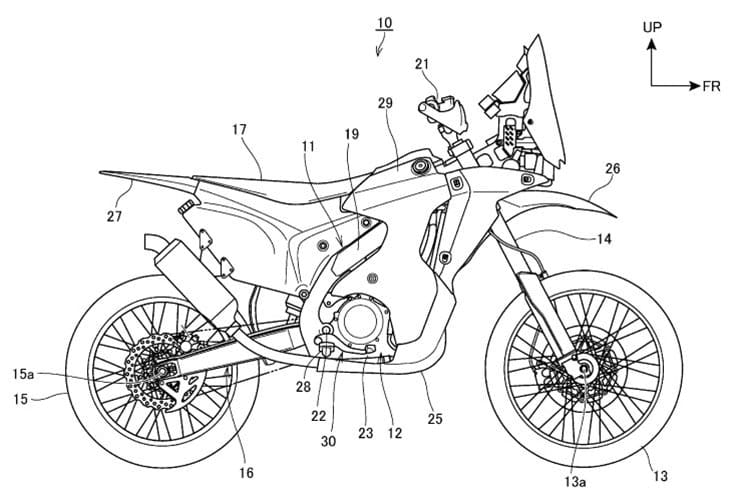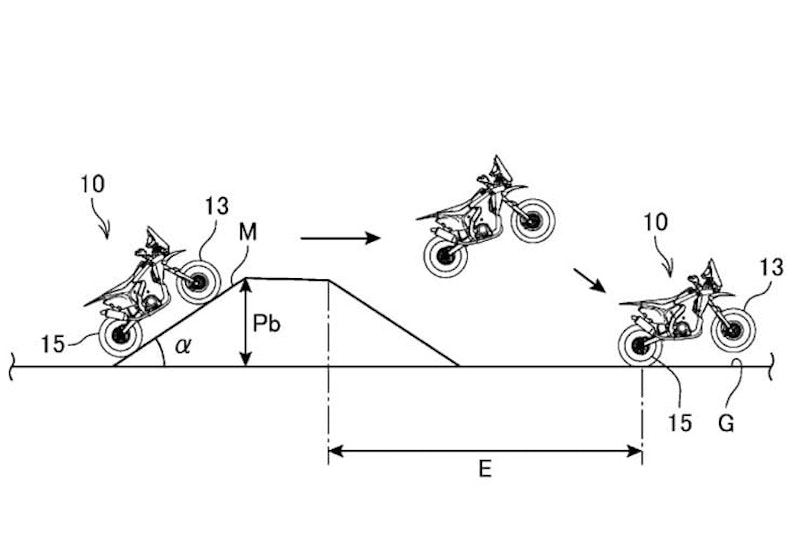Honda develops ‘Jump Control’
By Ben Purvis
Motorcycle Journalist
13.04.2023
Traction Control. Launch Control. Wheelie Control. Engine Brake Control. Slide Assist. The number of rider aids on top-end road bikes grows with every generation as manufacturers find new uses for the ever-expanding number of sensors scattered around modern motorcycles. Now they’re starting to delve into the possibilities that rider-assistance tech offers to off-road riders – as demonstrated by Honda’s designs for a ‘Jump Control’ system.
It might sound like an unnecessary stretch, but there’s logic in Honda’s thinking. In exactly the same way as traction control or ABS might make you braver when it comes to exploring the outer limits of both your abilities and your bike’s potential, a system that can help off-road riders feel their way into the process of jumping could be a useful way to accelerate their acquisition of riding skills while mitigating the chance of injury.
The Jump Control system has emerged in a newly-published patent application from Honda, proving it’s something that the firm’s R&D department is working on seriously enough to warrant the investment in patent protection.
Like other rider assists, it’s intended to offer a selection of different modes and to help prevent crashes, but it also involves technology that doesn’t yet feature on any production bike.
In operation, the system has three main modes. In ‘Mode A’ it completely prevents jumps, slowing the bike by automatically reducing the throttle or applying brakes before it reaches the take-off point. ‘Mode B’ allows jumps, but only within pre-set target distances – it will slow you down if you’re approaching take-off too fast – and in flight it modulates the throttle and rear brake to control the bike’s angle, targeting a level, two-wheeled landing.
‘Mode C’ is more extreme, but still gives the system some control. It aims at a rear-wheel landing, applying more throttle to bring the nose up if it starts to dip during flight, but applying rear brake if it rises too high, and again can have a pre-set target distance for the jump.
This illustrates the three modes of the Jump Control system
The system uses a variety of sensors, some already present on modern bikes, others not so familiar. An IMU and lean sensors, allied to info about throttle and brake positions, all feed into the system. It also has suspension travel sensors, which it uses alongside front and rear wheel speed measurements to judge whether the bike is still touching the ground.
One major element that isn’t present on today’s bikes is a front-facing camera, used to ‘see’ jumps as you approach them. It feeds an image to a computer system that recognises slopes as you approach, as well as their angle and height, to help estimate the size of the jump you’ll perform when you reach the top and the speed needed to either prevent it or to achieve the pre-set target jump distance.
Honda’s patent illustrates the system on a CRF450 Rally, which could indicate one area where the Jump Control system might come to the fore away from simply helping novice off-road riders. In rally-raids like the Dakar Rally, riders face hours in the saddle, often over dunes, and it’s not hard to imagine that Jump Control could come in handy in taking some of the pressure off the competitors.
The image ‘seen’ by the on-board camera as it identifies jumps ahead
Rider-assist technology is already starting to spread to off-road use. In fact, it arguably started there with selectable engine maps and power settings long before they started to appear on road bikes. Most recently we’ve seen Yamaha introduce an electric power steering system for motocross bikes, helping to reduce rider fatigue and improve stability. The same thinking could also open the door to more extreme bike setups in much the same way that modern fighter jets are designed to be inherently unstable, benefitting from greater manoeuvrability as a result but needing computer assistance to make them flyable.
As sensors and processors get ever cheaper, it’s a route that’s clearly tempting for any manufacturer to take in pursuit of a competitive edge.
Share on social media:

